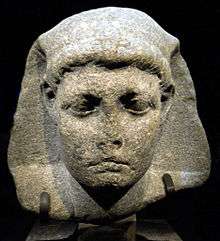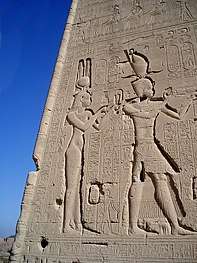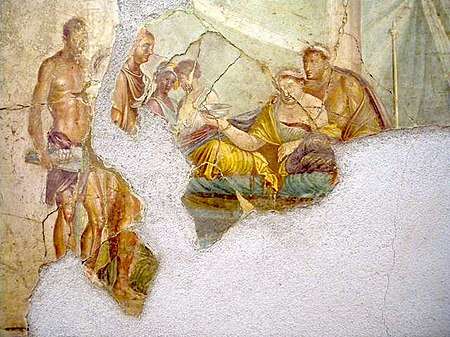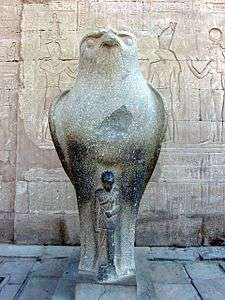Caesarion
Ptolemy XV Philopator Philometor Caesar (Koinē Greek: Πτολεμαῖος, Ptolemaĩos; 23 June 47 BC – 23 August 30 BC),[1] better known by the nickname Caesarion (Καισαρίων Caesariō), was the last pharaoh of ancient Egypt, reigning with his mother Cleopatra from 2 September 44 BC until her death by 12 August 30 BC and as sole ruler until his death was ordered by Octavian, the later Roman emperor Augustus.
| Caesarion | |
|---|---|
 Caesarion, from the "Unravel the Mystery" Cleopatra exhibit | |
| Pharaoh of Ptolemaic Egypt | |
| Reign | 2 September 44 BC – 12 August 30 BC alongside Cleopatra VII Philopator |
| Predecessor | Cleopatra |
| Successor | Caesar Augustus (as Roman emperor) |
| Born | 23 June 47 BC Egypt |
| Died | 23 August 30 BC (aged 17) Alexandria |
| Koine Greek | Πτολεμαῖος Φιλοπάτωρ Φιλομήτωρ Καῖσαρ, Καισαρίων |
| Transliteration | Ptolemaĩos Philopátōr Philomḗtōr Kaĩsar, Kaisaríōn |
| House | Julio-Claudian |
| Dynasty | Ptolemaic |
| Father | Julius Caesar |
| Mother | Cleopatra |
Caesarion was the eldest son of Cleopatra and possibly the only biological son of Julius Caesar, after whom he was named. He was the last sovereign member of the Ptolemaic dynasty of Egypt.
Early life


Right: a limestone stela of the High Priest of Ptah bearing the cartouches of Cleopatra and Caesarion, Egypt, Ptolemaic Period, the Petrie Museum of Egyptian Archaeology, London
Ptolemy Philopator Philometor Caesar (Koinē Greek: Πτολεμαῖος Φιλοπάτωρ Φιλομήτωρ Καῖσαρ, romanized: Ptolemaĩos Philopátōr Philomḗtōr Kaĩsar, lit. 'Ptolemy, Beloved of his Father, Beloved of his Mother, Caesar') was born in Egypt on 23 June 47 BC. His mother Cleopatra insisted that he was the son of Roman politician and dictator Julius Caesar, and while he was said to have inherited Caesar's looks and manner, Caesar did not officially acknowledge him. One of Caesar's supporters, Gaius Oppius, even wrote a pamphlet which attempted to prove that Caesar could not have fathered Caesarion. Nevertheless, Caesar may have allowed Caesarion to use his name.[2] The matter became contentious when Caesar's adopted son, Octavian, came into conflict with Cleopatra.
In some medical literature, Caesarion is said to have suffered from epilepsy, a neurological condition apparently inherited from his father.[3] This thesis has been disputed by paleopathologist Francesco M. Galassi and surgeon Hutan Ashrafian, who have argued that the first mention of potential epileptic attacks can only be found in 20th-century novels, instead of ancient primary sources. Additionally, they claimed that this controversial assumption had been mistakenly used in the historico-medical debate on Julius Caesar's alleged epilepsy to strengthen the notion that the dictator really suffered from that disease.[4]
Caesarion spent two of his infant years, from 46 to 44 BC, in Rome, where he and his mother were Caesar's guests at his villa, Horti Caesaris. Cleopatra hoped that her son would eventually succeed his father as the head of the Roman Republic, as well as of Egypt. After Caesar's assassination on 15 March 44 BC, Cleopatra and Caesarion returned to Egypt. Caesarion was named co-ruler by his mother on 2 September 44 BC at the age of three, although he was pharaoh in name only, with Cleopatra keeping actual authority. Cleopatra compared her relationship to her son with that of the Egyptian goddess Isis and her divine child Horus.[2]
There is no historical record of Caesarion between 44 BC until the Donations of Antioch in 36 BC. Two years later he also appears at the Donations of Alexandria. Cleopatra and Antony staged both "Donations" to donate lands dominated by Rome and Parthia to Cleopatra's children: Caesarion, the twins Alexander Helios and Cleopatra Selene II, and Ptolemy Philadelphus (the last three were his maternal half-siblings fathered by Mark Antony). Octavian gave public approval to the Donations of Antioch in 36 BC, which have been described as an Antonian strategy to rule the East making use of Cleopatra's unique royal Seleucid lineage in the regions donated.[5]
Pharaoh
In 34 BC, Antony granted further eastern lands and titles to Caesarion and his own three children with Cleopatra in the Donations of Alexandria. Caesarion was proclaimed to be a god, a son of [a] god, and "King of Kings". This grandiose title was "unprecedented in the management of Roman client-king relationships" and could be seen as "threatening the 'greatness' of the Roman people".[6] Antony also declared Caesarion to be Caesar's true son and heir. This declaration was a direct threat to Octavian (whose claim to power was based on his status as Julius Caesar's grandnephew and adopted son). These proclamations partly caused the fatal breach in Antony's relations with Octavian, who used Roman resentment over the Donations to gain support for war against Antony and Cleopatra.[7]
Death

After the defeat of Mark Antony and Cleopatra at the Battle of Actium in 31 BC, Cleopatra seems to have groomed Caesarion to take over as "sole ruler without his mother".[2] She may have intended to go into exile, perhaps with Antony, who may have hoped that he would be allowed to retire as Lepidus had. Caesarion reappears in the historical record in 30 BC, when Octavian invaded Egypt and searched for him. Cleopatra may have sent Caesarion, 17 years old at the time, to the Red Sea port of Berenice for safety, possibly as part of plans for an escape to India; he may have been sent years earlier, but the sources are unclear. Plutarch does say that Caesarion was sent to India, but also that he was lured back by false promises of the kingdom of Egypt:
Caesarion, who was said to be Cleopatra's son by Julius Caesar, was sent by his mother, with much treasure, into India, by way of Ethiopia. There Rhodon, another tutor like Theodorus, persuaded him to go back, on the ground that [Octavian] Caesar invited him to take the kingdom.[9]
Octavian captured the city of Alexandria on 1 August 30 BC, the date that marks the official annexation of Egypt to the Roman Republic. Around this time Mark Antony and Cleopatra died, traditionally said to be by suicide, though murder has been suggested.[10] Details of the narratives in Plutarch are generally challenged and not taken literally.[11] Caesarion's guardians, including his tutor, were themselves either lured by false promises of mercy into returning him to Alexandria or simply betrayed him; the records are unclear.
Octavian is supposed to have had Pharaoh Caesarion executed in Alexandria, following the advice of Arius Didymus, who said "Too many Caesars is not good" (a pun on a line in Homer).[12] It is popularly thought that he was strangled, but the exact circumstances of his death have not been documented. Octavian then assumed absolute control of Egypt. The year 30 BC was considered the first year of the new ruler's reign according to the traditional chronological system of Egypt.
Depictions

 One of two statues of the falcon god Horus behind a smaller depiction of Caesarion at the Temple of Edfu in Edfu, Upper Egypt[16]
One of two statues of the falcon god Horus behind a smaller depiction of Caesarion at the Temple of Edfu in Edfu, Upper Egypt[16]
Few images of Caesarion survive. He is thought to be depicted in a partial statue found in the harbor of Alexandria in 1997 and is also portrayed twice in relief, as an adult pharaoh, with his mother on the Temple of Hathor at Dendera. His infant image appears on some bronze coins of Cleopatra.[17]
Egyptian names
In addition to his Greek name and nicknames, Caesarion also had a full set of royal names in the Egyptian language:
Caesarion as fictional character
- Caesarion is the main character of the historical novel Cleopatra's Heir by Gillian Bradshaw (2002, ISBN 0765302284).
- In the comic album Asterix and Son, Cleopatra leaves an infant Caesarion in the care of the invincible Gaul Asterix, to protect him from being murdered by Brutus.
- In the Virgin Missing Adventures Doctor Who novel State of Change, the Sixth Doctor and Peri Brown arrive in a duplicate of the Roman Empire that has acquired advanced technology after gaining access to a copy of the Doctor's TARDIS console, with the Doctor and Peri's primary ally in this new world being a duplicate of Caesarion – now officially known as Ptolemy – who is now in his mid-thirties after the Romans' acquisition of technology prevented the fall of their empire, the two helping Ptolemy depose his feuding half-siblings (Cleopatra's twin children with Mark Antony).
- Caesarion, appearing in the 2005–2007 TV series Rome. He is depicted in several episodes of the TV series. He first appears in the episode "Caesarion" as a newborn child and plays a major role in the final episode "De Patre Vostro (About Your Father)", in which he is rescued from death by Titus Pullo, leaving with him to an unknown future. The series strongly implies that Pullo, who had sex with Cleopatra before she met Caesar, is the boy's real father. The title of the final episode, the last words Pullo says to Caesarion before the series ends, alludes to this.
- Caesarion is a lead character in Michael Livingston's 2015 historical fantasy novel The Shards of Heaven.[19][20]
- He is a character in Colleen McCullough's Masters of Rome series, in particular in the final book titled Antony and Cleopatra.
- He is a character in the 1963 film Cleopatra, depicted mainly as a child throughout.
- Caesarion plays a small role in the 2017 video game Assassin's Creed Origins.
See also
- Caesareum of Alexandria
- Gens Julia
- List of unsolved murders
- Reign of Cleopatra
Notes
References
- "'Little Caesar': Forgotten 'King Of Kings' Who Died Very Young". Ancient Pages. 11 May 2020. Retrieved 16 May 2020.
- Duane W. Roller, Cleopatra: A Biography, Oxford University Press US, 2010, pp. 70-3
- Hughes J.R. (October 2004). "Dictator Perpetuus. Julius Caesar – Did he have seizures? If so, what was the etiology?". Epilepsy Behav. 5 (5): 765–764. doi:10.1016/j.yebeh.2004.06.002. PMID 15380132.
- Francesco M. Galassi; Hutan Ashrafian (2016). Julius Caesar's Disease. A New Diagnosis. Pen and Sword Books. pp. 45–46.
- Rolf Strootman (2010). "Queen of Kings: Cleopatra VII and the Donations of Alexandria". In M. Facella; T. Kaizer (eds.). Kingdoms and Principalities in the Roman Near East. Occidens et Oriens. 19. Stuttgart, DE: Franz Steiner Verlag. pp. 139–158.
- Meyer Reinhold (2002). Studies in Classical History and Society. US: Oxford University Press. p. 58.
- Burstein, Stanley Mayer (2007). The Reign of Cleopatra. University of Oklahoma Press. p. 29.
- Roller, Duane W. (2010). Cleopatra: A Biography. Oxford, UK: Oxford University Press. pp. 178–179. ISBN 9780195365535.
- Plutarch, Life of Antony. As found in the Loeb Classical Library, Plutarch's Lives: With an English Translation by Bernadotte Perrin. Volume 9. p. 321.
- Pat Brown (19 February 2013). The Murder of Cleopatra: History's Greatest Cold Case. Prometheus Books.
- The Victorian scholar Arthur Hugh Clough, who updated the poet John Dryden's superb translation of Plutarch to give us the best available version in English, remarked in an introduction: It cannot be denied that [Plutarch] is careless about numbers, and occasionally contradicts his own statements. A greater fault, perhaps, is his passion for anecdote; he cannot forbear from repeating stories, the improbability of which he is the first to recognise. Morrow, Lance (July 2004). "Plutarch's Exemplary Lives". Smithsonian Magazine. Retrieved 26 February 2015.
- David Braund et al, Myth, History and Culture in Republican Rome: Studies in Honour of T.P. Wiseman, University of Exeter Press, 2003, p. 305. The original line was "ουκ αγαθόν πολυκοιρανίη" ("ouk agathon polukoiranie"): "too many leaders are not good", or "the rule of many is a bad thing". (Homer's Iliad, Book II. vers 204–205) In Greek "ουκ αγαθόν πολυκαισαρίη" ("ouk agathon polukaisarie") is a variation on "ουκ αγαθόν πολυκοιρανίη" ("ouk agathon polukoiranie"). "Καισαρ" (Caesar) replacing "κοίρανος", meaning leader.
- The wall-painting of Venus Genetrix is similar in appearance to the now-lost statue of Cleopatra erected by Julius Caesar in the Temple of Venus Genetrix, within the Forum of Caesar. The owner of the House at Pompeii of Marcus Fabius Rufus, walled off the room with this painting, most likely in immediate reaction to the execution of Caesarion on orders of Augustus in 30 BC, when artistic depictions of Caesarion would have been considered a sensitive issue for the ruling regime.
- Roller, Duane W. (2010). Cleopatra: A Biography. Oxford, UK: Oxford University Press. p. 175. ISBN 9780195365535.
- Walker, Susan (2008). "Cleopatra in Pompeii?". Papers of the British School at Rome. 76: 35–46, 345–348. doi:10.1017/S0068246200000404.
- Fletcher, Joann (2008), Cleopatra the Great: The Woman Behind the Legend, New York: Harper, pp. 219, image plates and caption between 246–247, ISBN 978-0-06-058558-7
- Sear. Greek Coins and Their Values. II.
- Peter Clayton (1994), Chronicle of the Pharaohs, ISBN 0-500-05074-0
- "The Shards of Heaven by Michael Livingston". Publishers Weekly. Retrieved 29 January 2016.
- "Review: The Shards of Heaven by Michael Livingston". Kirkus Reviews. 3 September 2015. Retrieved 29 January 2016.
External links
- Ptolemy XV Caesarion entry in historical sourcebook by Mahlon H. Smith
Caesarion Born: 47 BC Died: 30 BC | ||
| Preceded by Cleopatra VII Philopator |
Pharaoh of Egypt 44–30 BCE with Cleopatra VII |
Egypt annexed by Rome |